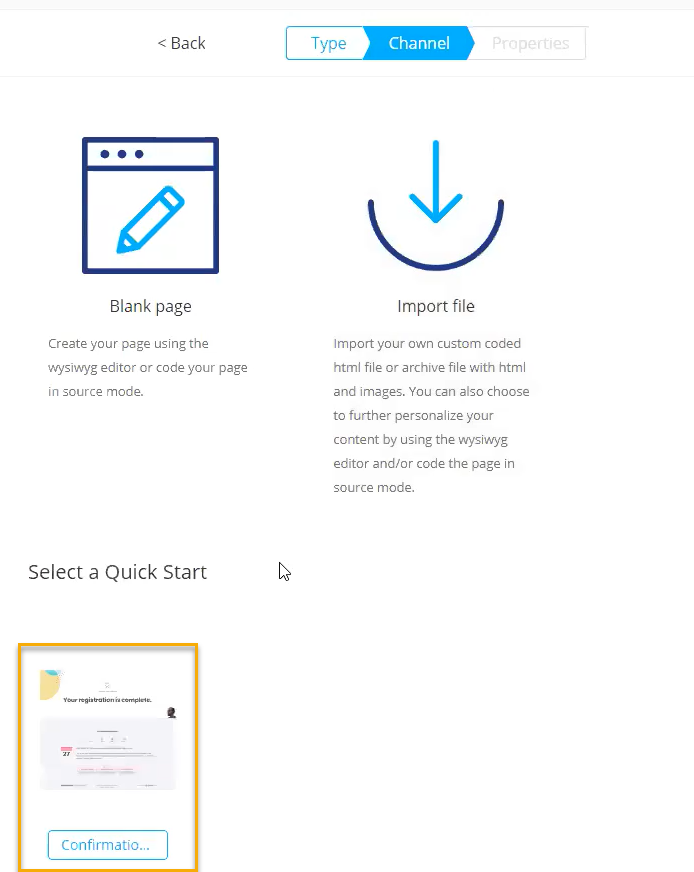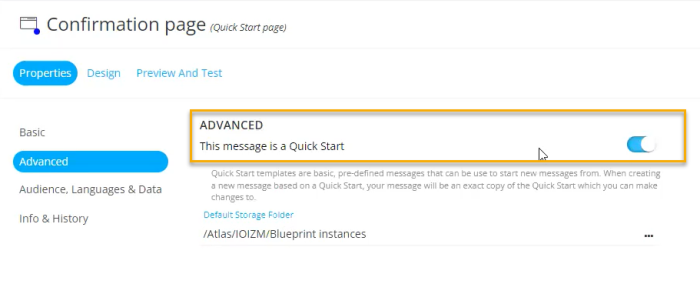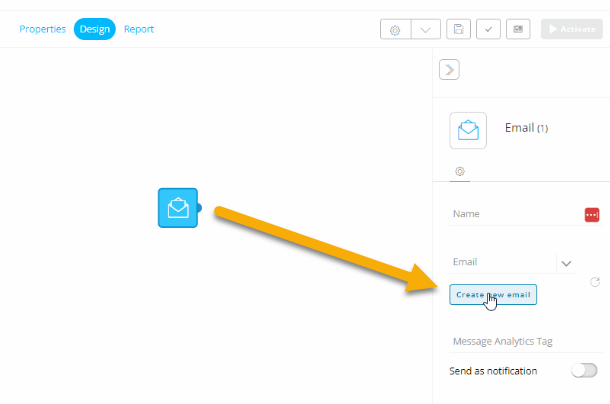Highlights in SMC
January 2023
Versions 5.32 - 5.34
Quick Start Enhancements
Quick Starts for Pages
In this release, we now also have the ability to save a Page as a Quick Start and create new pages from Quick Starts. This extends the current Quick Start functionality from emails to pages. The same rules apply for page Quick Starts as for email Quick Starts.
- Only published Quick Start pages can be used to create a new page
- Only pages that have not yet been used in a journey can be set as a Quick Start page
- Pages created from a Quick Start can be completely customized and are unlinked to the original Quick Start page
- Pages created from Quick Starts can be used in any type of journey
Upon creation of a new page from a Quick Start, all available Quick Start pages are listed:
Setting a page as a Quick Start is done from the Advanced properties of the page.
When a page is set as a Quick Start, it appears with a blue dot in the overview screen:
Other Quick Start Enhancements
Also, when creating a new content from within a Journey (by adding an Email Component to a Custom Journey and creating a new email instead of selecting an existing one), and a Quick Start is used, certain information should not be taken from the Quick Start but from the journey. This includes the Audience List which will be prefilled and read-only when creating the email.
Local Download of Export Data

Previously, when creating a data export, it was always exported to an external location (such as an FTP, Cloud storage, ...). Now, it is possible to also download the exported data locally to a CSV file.
Note: This feature is available on request.
Therefore, upon creation of a new data export a new target has been added: Download link.

When this target is selected, a file name can be entered, manually or by using personalization fields.
This download link becomes available on the import/export dashboard after the export has been executed.
Without executing the export, no data would be available yet. Also, the Download link expires after 30 days. If you want to download the data after these 30 days, you need to re-execute the export.
Body in Web Custom Component

In one of the previous releases we introduced the ability to define a header for the Web Custom Component.
Now it is also possible to optionally define the body for a Web Custom Component. The body is used to define additional parameters that can be passed onto the endpoint, and is written in JSON format.
When creating a Web Custom Component, you can toggle between the body type ‘No Body’ and ‘JSON’.
When the user decides to use a JSON body, the body structure editor and parameters grid is displayed below.
Body Structure
When the user enters a JSON object sample in the Body Structure area (most likely copied and pasted), automatically the parameters grid below is filled out with the parameters, values and value types (see below in the section Body Parameters).
Also, any values inside the pasted JSON object in the Body Structure will automatically be replaced by placeholders (eg. “{{Firstname}}”).
For example :
When copy-pasting the following JSON into the Body Structure :
{
"Firstname": "Firstname",
"Lastname": "Lastname",
"City": "TestCity",
"Optin": false,
"Additional": {
"UserKey": 1000,
"Nickname": "Nick"
}
}
This results in the following to be shown :
The reasoning behind this is that the Body Structure section is designed to define the JSON 'structure'.
'Values' need to be changed in the Body Parameters grid underneath, and should not be touched in the structure area.
You can also update the JSON structure manually in this field.
Warning: Keep in mind that when manually editing content in the Body Structure field, updating parameter values won't have any effect on existing parameters in the Body Parameters grid !
The values linked to the existing JSON parameters will still be shown in the Body Parameters grid (the system keeps these in its memory).
As the purpose of the Body Structure is to define the JSON structure, it only makes sense to add / remove parameters in here, or update parameter names.
The user can then make changes directly in the grid, such as changing the type, values and options (editable - exposed and configurable at journey level, nullable - or empty string, sensitive - encrypted in the backend code).
The parameters and values that are in the grid will be the ones that are going to be saved.
Body Parameters
The body parameters grid offers the same functionality as for the Web Custom Component header parameters released earlier:
- ‘editable’ tick box - Makes the parameter editable in a journey (ticked by default)
- parameter ‘name’ - Each body parameter name is a read-only field that gets auto-populated with the name set in the Body Structure.
- parameter ‘value’ - Editable value.
- ‘sensitive’ - Encrypts the parameter in the journey
The body parameters additionally contain the following properties:
- ‘type’ – Can be boolean, text, numeric.
- ‘nullable’ – To allow NULL values for the parameter. Only applies to parameters of type ‘text’.
Note: The JSON parameters are shown in the Body Parameters grid with a particular format.
Some examples :
1. "password": { "value": "{{password.value}}" }
=> This will give the name “password.value” in the grid.
2. an array example :
"Pet": [ { "Name": "{{Pet.0.Name}}", "Species": "{{Pet.0.Species}}" }, { "Name": "{{Pet.1.Name}}", "Species": "{{Pet.1.Species}}" ]
=> This will give the name “Pet.0.Name, Pet.0.Species, Pet.1.Name, Pet.1.Species” in the grid.







